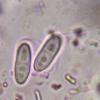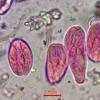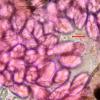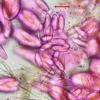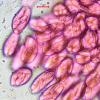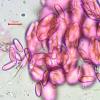
14-02-2025 16:00
 Lothar Krieglsteiner
Lothar Krieglsteiner
during a workshop on corticiaceous fungi this was

13-02-2025 07:41
first time I encounter it. I didn't expect to see

14-02-2025 12:57
Gernot FriebesHello,we are looking for ideas regarding this pyre

13-02-2025 22:39
Yanick BOULANGERBonsoirPetits périthèces noirs d'environ 0.5 mm

11-02-2025 13:06
 Blasco Rafael
Blasco Rafael
Hola, alguna idea de que puede ser esta muestra ??

23-02-2022 18:55
William de JongHi everyone,I found an ascomycete on a twig of Rob

22-09-2009 09:47
Bonjour, Curieuse récolte que ce Pleospora imme

10-02-2025 16:40
Karen PoulsenHello, I found these fungi on dead branches of Fa
hymenial parasite in old Xenasmatella vaga specimen
Lothar Krieglsteiner,
14-02-2025 16:00
 during a workshop on corticiaceous fungi this was in a sample of Xenasmatella vaga. There were a lot of asci quite "out of nowhere", with 1-celled spores partly becoming 2-septate and mostly about 11-12/4 µm large (more exact measurements can be done out of the pictures).
during a workshop on corticiaceous fungi this was in a sample of Xenasmatella vaga. There were a lot of asci quite "out of nowhere", with 1-celled spores partly becoming 2-septate and mostly about 11-12/4 µm large (more exact measurements can be done out of the pictures). I know only Helicogonium which does not seem to fit (2 species in aphyllophoralean fungi known, different).
Does somebody know other ascomycetous hymenial parasites? And perhaps does somebody know this fungus?
Best, Lothar (sample from Germany)
(first foto in KOH, other fotos in KOH plus phloxine)
Hans-Otto Baral,
14-02-2025 17:12

Re : hymenial parasite in old Xenasmatella vaga specimen
Hallo Lothar,
"out of nowhere" is a bit odd, is it impossible to make a section to show the asci in situ? Were they side by side with basidia?
Was it only at one spot? I assume you tested IKI?
Zotto
Lothar Krieglsteiner,
14-02-2025 17:27

Re : hymenial parasite in old Xenasmatella vaga specimen
Hallo Zotto,
nein - ich kam nicht dazu, weitere Präparate zu machen. Es ging wie gesagt um Cortis und das Ziel war nicht wirklich, hymeniale Ascomyceten zu bearbeiten.
Es war tatsächlich so, dass ein Brocken Asci mehr oder weniger inmitten des Zupf-Präparates der Xenasmatella war. Nachdem ich zuerst in KOH präpariert hatte (das ist bei Cortis üblich), habe ich Phloxin nachgeladen. In KOH hatte ich zuerst nur wenige Schläuche inmitten der Xenasmatella-Probe gesehen, danach mit Phloxin habe ich in einem anderen Eck ganz viele Schläuche auf einem Haufen gefunden. Andere Strukturen habe ich nicht gesehen.
Man könnte denken, dass ein Fruchtkörper eines Ascomyceten in der Xenasmatella war. Von Gehäuse habe ich allerdings nicht eine Spur gesehen. Nur die Corti-Probe und die Asci.
Ich werde bei Gelegenheit versuchen, ob ich in der Probe der Xenasmatella (ich habe sie behalten) weitere Schläuche finde. Dann kann ich auch noch IKI versuchen. Dazu habe ich mir beim Corti-Workshop keine Zeit genommen. Ich melde mich wieder, wenn ich das getan habe.
Gruß Lothar
nein - ich kam nicht dazu, weitere Präparate zu machen. Es ging wie gesagt um Cortis und das Ziel war nicht wirklich, hymeniale Ascomyceten zu bearbeiten.
Es war tatsächlich so, dass ein Brocken Asci mehr oder weniger inmitten des Zupf-Präparates der Xenasmatella war. Nachdem ich zuerst in KOH präpariert hatte (das ist bei Cortis üblich), habe ich Phloxin nachgeladen. In KOH hatte ich zuerst nur wenige Schläuche inmitten der Xenasmatella-Probe gesehen, danach mit Phloxin habe ich in einem anderen Eck ganz viele Schläuche auf einem Haufen gefunden. Andere Strukturen habe ich nicht gesehen.
Man könnte denken, dass ein Fruchtkörper eines Ascomyceten in der Xenasmatella war. Von Gehäuse habe ich allerdings nicht eine Spur gesehen. Nur die Corti-Probe und die Asci.
Ich werde bei Gelegenheit versuchen, ob ich in der Probe der Xenasmatella (ich habe sie behalten) weitere Schläuche finde. Dann kann ich auch noch IKI versuchen. Dazu habe ich mir beim Corti-Workshop keine Zeit genommen. Ich melde mich wieder, wenn ich das getan habe.
Gruß Lothar
